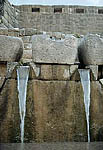 The Impact Formula
The Impact Formula The Impact Formula
The Impact Formula
![]()
As the concept of human impact on the environment has shifted in meaning and scope, it is important to investigate how we depend on the surrounding resources -- today referred to as the footprint, or "carbon footprint" on the planet. The idea was suggested by Paul Ehrlich and John Holdren a generation ago as a formula for the purpose of comparing different places and the influence of those different settlements on their surroundings. For instance a person in India has significantly less impact on their surroundings than does a Western European, a Japanese, or North American individual because --although their population is over a billion, East Indian people use less water, food and fuel than you do.
Obvious versus hidden impacts on the surrounding habitat.
Both the accumulation of N (nitrogen) and P (phosphorus) are indicators of an impact of human settlement that often goes unseen from the perspective of growth and development of settlements.
![]()
![]() he formula is:
he formula is:
Impact is equal to population times affluence times technology. |
||
|
Human impact grows ever wider over the years. |
||
| times | ||
| times | ||
![]()
There are difficulties with this sort of thinking from an economists or a sociologists viewpoint. Growth in economics and especially affluence is a good thing that drives markets to reallocate resources more efficiently, or so the theory goes. But to what extent does the distribution of goods and services influence human well being?
In sociology, demographic analysis is just the start of an initial inquiry into human needs. Affluence, in many countries will enable, for example, the society to make medical care, education, public safety and recreational opportunities available to more people, and not merely impose burdens on scarce resources. For this reason, how a society allocates its economic returns for social improvement, MORRIS DAVID MORRIS developed the physical quality of life index.
But from a demographical and ecological perspectives there are some startling discoveries when you use the formula and discover that states like California or Florida have far greater population pressures than does Oregon.
The unseen pressure of population on the surrounding and even distant environments can be thought of in terms of ghost acres as the use of resources adversely alters land, air and water. In addition there exist direct and indirect impacts of human settlements and domesticated plants and animals on native species.
what are environmental assets?
Ways to measure human well being.
PQLI = Physical Quality of Life
HDI = Human Development Index
PQLI = The physical quality-of-life index (PQLI) is an attempt to measure the quality of life or well-being of a country. The value is the average of three statistics: basic literacy rate, infant mortality, and life expectancy at age one, all equally weighted on a 0 to 100 scale.HDI = The Human Development Index (HDI) is an index combining normalized measures of life expectancy, literacy, educational attainment, and GDP per capita for countries worldwide.
Two means of economic measuring:
GDP,
GDP at purchaser's prices is the sum of gross value added by all resident producers in the economy plus any product taxes and minus any subsidies not included in the value of the products. It is calculated without making deductions for depreciation of fabricated assets or for depletion and degradation of natural resources. Data are in current U.S. dollars. Dollar figures for GDP are converted from domestic currencies using single year official exchange rates. For a few countries where the official exchange rate does not reflect the rate effectively applied to actual foreign exchange transactions, an alternative conversion factor is used. World Bank data base.
GNI,
GNI per capita (formerly GNP per capita) is the gross national income, converted to U.S. dollars using the World Bank Atlas method, divided by the midyear population. GNI is the sum of value added by all resident producers plus any product taxes (less subsidies) not included in the valuation of output plus net receipts of primary income (compensation of employees and property income) from abroad. GNI, calculated in national currency, is usually converted to U.S. dollars at official exchange rates for comparisons across economies, although an alternative rate is used when the official exchange rate is judged to diverge by an exceptionally large margin from the rate actually applied in international transactions. To smooth fluctuations in prices and exchange rates, a special Atlas method of conversion is used by the World Bank. This applies a conversion factor that averages the exchange rate for a given year and the two preceding years, adjusted for differences in rates of inflation between the country, and through 2000, the G-5 countries (France, Germany, Japan, the United Kingdom, and the United States). From 2001, these countries include the Euro area, Japan, the United Kingdom, and the United States. World Bank data indices.